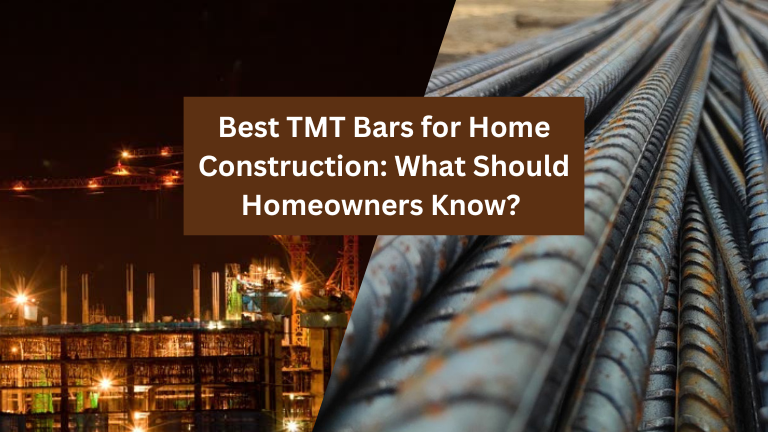When it comes to building a home that is strong, safe, and durable, selecting the right construction materials becomes crucial. Among these materials, TMT bars (Thermo Mechanically Treated bars) play a foundational role in determining the structural integrity of your house. These reinforcement bars are used in Reinforced Cement Concrete (RCC) construction, offering the required tensile strength and ductility to withstand loads, natural disasters, and environmental stress. But with so many brands and grades in the market, how do you decide which TMT is best for RCC or which TMT bar for home construction will ensure a long-lasting shelter?
This blog will walk you through everything a homeowner should know — from understanding TMT bars to selecting the best one for your home construction — backed by information available in Indian Standard codes, BIS norms, and construction manuals issued by government bodies like CPWD (Central Public Works Department) and IS (Indian Standards).
What is a TMT Bar and Why is it Essential for RCC Homes?
TMT bars are steel reinforcement bars that undergo a special thermo-mechanical treatment process. This treatment provides them with a hard outer surface and a soft, ductile core. These properties make them ideal for RCC, where concrete provides compressive strength while steel bars provide tensile strength.
According to IS 1786:2008, which defines the standard for high-strength deformed steel bars and wires for concrete reinforcement in India, the quality of TMT bars must meet specific chemical composition, tensile strength, elongation, and bendability standards.
Key Qualities Homeowners Should Look For in a TMT Bar
When choosing a TMT bar for home construction, ensure it satisfies the following criteria based on Indian building codes:
1. Grade and Strength
TMT bars come in various grades like Fe 415, Fe 500, Fe 550, and Fe 600, which indicate their yield strength in N/mm². For residential homes:
Fe 500 and Fe 500D are considered ideal as they offer a perfect balance between strength and ductility.
Fe 500D provides enhanced elongation (as per IS 1786), which is crucial for areas prone to earthquakes.
2. Earthquake Resistance
For seismic zones (Zone III, IV, and V), the Bureau of Indian Standards (BIS) recommends using TMT bars with higher ductility like Fe 500D or Fe 550D. Ductile TMT bars can absorb seismic shocks and prevent sudden collapse.
3. Corrosion Resistance
If your home is near the coast or in a high-moisture zone, corrosion-resistant TMT bars are essential. Many top brands now manufacture CRS (Corrosion Resistant Steel) bars treated with anti-corrosive chemicals.
4. Bendability and Weldability
Good TMT bars must bend without cracking and should have excellent weldability — a requirement emphasized in IS code manuals for RCC practices. This helps in customized reinforcement placement as per architectural design.
5. Certification and Testing
Always choose TMT bars that are BIS certified and undergo regular third-party lab testing for parameters like tensile strength, elongation, and chemical composition (carbon, sulfur, phosphorus content).
Which TMT is Best for RCC in Home Construction?
For RCC residential buildings, the most recommended grades by government specifications and structural engineering norms are:
- Fe 500D: Best suited for all types of residential RCC structures. Offers high tensile strength (≥500 N/mm²) and ductility (elongation ≥16%).
- Fe 550D: Preferred in high-rise or heavy-load homes.
- Fe 500 CRS: Ideal for coastal and saline environments.
Ensure you buy Top TMT bars that conform to IS 1786, and have test reports readily available. Government construction manuals such as the CPWD Specifications 2019 Volume 1 & 2 also suggest using TMT bars that match the structural load and environmental conditions of the project site.
Popular TMT Brands in India for Home Construction
While multiple local and national brands are available, here are some of the reputed TMT bar brands widely used for home construction, known for quality, consistency, and BIS certification:
These brands offer Fe 500/Fe 500D and even Fe 550D variants with features like earthquake resistance, anti-corrosion, and better bendability, compliant with IS norms.
Tips for Buying the Right TMT Bar for Your Home
1. Check for ISI Marking: Ensure the bars are IS 1786 certified.
2. Inspect Branding on the Bar: Quality TMT bars have embossed branding for traceability.
3. Ask for Lab Test Reports: Always demand recent lab test results from your supplier.
4. Buy from Authorized Dealers: This ensures authenticity and proper handling of materials.
5. Avoid Mixing Brands: Mixing bars with different compositions can weaken structural integrity.
6. Consult a Structural Engineer: Get a steel quantity estimate and bar grade recommendation.
Government Guidelines for Using TMT Bars
According to the National Building Code (NBC) 2016, and CPWD works manuals, the following practices are essential:
- RCC work must be done using steel of proper grade and quality.
- Bars should be stored off-ground and covered to prevent rust.
- Cutting and bending should follow standard bar bending schedules.
- Proper overlap, anchorage, and spacing should be maintained as per the structural drawing.
Moreover, the Earthquake Resistant Design Guidelines issued by the Bureau of Indian Standards (IS 13920) emphasize using ductile TMT bars for seismic resistance in residential buildings.
Final Thoughts
Choosing the right TMT bar for home construction is more than just picking a brand — it involves understanding the technical specifications, local environmental conditions, and adhering to national building standards. Whether you’re building a one-story house or a multi-story home, ensure you use Fe 500D or Fe 550D grade TMT bars, certified by BIS, and sourced from reliable manufacturers.
If you’re wondering which TMT is best for RCC, the answer lies in balancing strength, ductility, and durability while aligning with IS 1786 guidelines. A strong foundation ensures not just a robust structure but also peace of mind for years to come.

